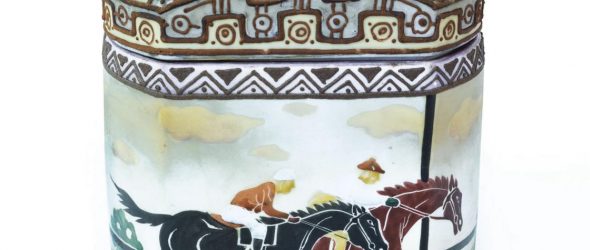A reader sent us a picture of an item in an auction catalog that looked like a cookie jar decorated with racing horses, but it had a strange lid. What else could it be? Why horses on a cookie jar? The lid and the size, 7 inches high, are clues. The jar is a humidor, a container for cigars, cigarettes, pipe tobacco and even cannabis that keeps the tobacco moist and shields it from sunlight, insects and damage. Humidors were necessary and very popular in the late 1880s to early 1900s, when smoking cigars was a sign of masculinity. Most vintage humidor cases are made of attractive wood and lined with Spanish cedar, a wood that holds moisture and does not warp. It also has a pleasant odor and discourages tobacco beetles. But humidors were also made of glass, ceramics, metal or even plastic. The humidor pictured is marked with an “M” in a green wreath, the trademark used by the Morimura Brothers Company, a New York City import firm that operated from 1911 to the 1950s. The humidor is called the Kentucky Derby Scenic. It was probably made by Noritake, a Japanese company.
Q What’s the best way to clean a rubber doll? I’ve had mine for about 65 years, and it has a lot of sentimental value to me. It closes its eyes when it’s laid down, cries when squeezed and has hair that can be combed. It’s dirty from having been played with then left sitting in a corner. I cleaned it with Dawn detergent and water, but I don’t think it did a thing. Is there something else I can use, or do I just accept that my neglect stays on the doll?
A There are a few things you can try, but remember to test them out in an inconspicuous place, like the bottom of the doll’s foot, first. It’s better to have a slightly dirty doll than one that’s ruined. Try rubbing off the dirt with undiluted detergent instead of detergent and water, or use a damp cloth dipped in baking soda and rub it on the doll. Other suggestions include rubbing the doll with an art eraser or using a damp “magic eraser.” Just don’t use anything that contains bleach.
Q I grabbed a huge silver-colored pineapple at the opening of a house sale. I discovered that the top opens, and it is lined with white plastic. It is marked M.M. Firenze. I think it’s an ice bucket. I paid $25. Did I get a bargain?
A Yes. You bought an Italian ice bucket made in the late 1960s by Fonderia d’Arte. The company made silver colored barware with gold colored trim designed by Mauro Manetti. Examples of this popular aluminum ice bucket sold for $400 to $1,000 this year.
Q I have two curio cabinets labeled “Jasper.” I purchased them in the 1960s from Harlem Furniture Co. in Dayton, Ohio. I was hoping that you could help me out with finding new keys! Thank you.
A If owners of antique furniture collectors are lucky, their pieces have the original key. If you don’t see a key, check to see if it’s taped in a drawer or on the back panel. Don’t remove the lock, it will damage the furniture. Call a locksmith. Ask an antiques dealer or auction gallery if it can suggest a locksmith who repairs antiques. There are master keys for most types of locks — old or new, furniture, house or filing cabinet, even clocks and coin-operated machines.
Q I inherited my mother’s set of a pitcher and cups, and would like to know their value. She had them for over 85 years. They look like white mother-of-pearl with blue trim. The pitcher has a blue handle on the side and a knob on the lid. There are five perfect cups; one has a chip. They are marked “K.T. & K.” Can you estimate the price?
A KTK are the initials of the Knowles, Taylor & Knowles Company of East Liverpool, Ohio. Isaac W. Knowles started a pottery in 1853. His son, Homer Knowles, and son-in-law, John Taylor, joined the company in 1870. The company merged with American Ceramic Corporation in 1928. It closed during the Depression in 1931. The pitcher probably came with six cups. You don’t have the full set and one of the cups is chipped, lowering the value.
Q I inherited my dad’s medical schoolbooks from the 1940s and ‘50s. They’re all in very good condition. I’ve tried selling them online with no takers, and bookstores in the area won’t take them. Is there a place where I can sell them, maybe at an antique or vintage bookstore?
A Textbooks that aren’t current don’t sell well. A medical textbook from the mid-1800s or earlier might have some historic value, especially if it has advertisements in it. An 1865 edition of “Gray’s Anatomy” sold at auction last year for $168.
TIP: Wrap jewelry in acid-free tissue or in cotton bags to keep pieces from bumping and scratching.
By sending a letter with a question, you give full permission for use in any Kovel forum. For return of a photograph, include a stamped envelope. Write to Kovel, Farm Forum, King Features Syndicate, 300 W. 57th St., 15th Floor, New York, NY 10019.


